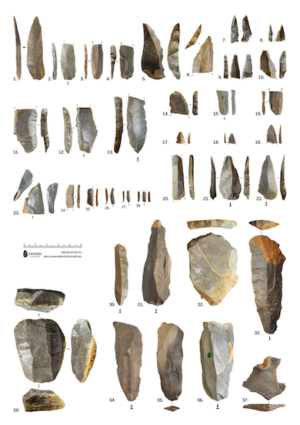
PLOS—Neanderthal populations in the Iberian Peninsula were experiencing local extinction and replacement even before Homo sapiens arrived, according to a study* published March 30, 2022 in the open-access journal PLOS ONE by Joseba Rios-Garaizar of the Archaeological Museum of Bilbao, Spain and colleagues.
Neanderthals disappeared around 40,000 years ago, but many details of their extinction remain unclear. To elucidate the situation, it is useful to explore how Neanderthal populations were changing during their final millennia. In this study, researchers examined the distribution of a tool complex known as the Châtelperronian, which is thought to be unique to certain populations of Neanderthals in France and the Iberian Peninsula.
The researchers examined over 5,000 remains of Châtelperronian tools from a site called Aranbaltza II in Barrika, in the Northern Iberian Peninsula, dating to around 45,500 years ago. Comparing this site with other nearby Neanderthal tool sites, they document that the Châtelperronian system does not overlap in time with older Neanderthal technologies in this region, suggesting that Châtelperronian tools were not developed from earlier Iberian technology, but instead originated elsewhere before migrating into the region. They also found that Châtelperronian tools appear earlier than the first Homo sapiens tools in the Iberian Peninsula.
Based on this evidence, the authors suggest that older Iberian Neanderthal populations disappeared, taking their tool styles with them, and were replaced by different Neanderthal groups using Châtelperronian tools, likely migrating from France, and these populations were in turn replaced by Homo sapiens. The researchers propose that these patterns of local Neanderthal extinction and replacement will be an important area of future study, as they might have played a significant role in the decline and ultimate demise of Neanderthals.
The authors add: “Neanderthals with Châtelperronian technology occupied the Northern Iberian Peninsula ca. 43,000 years ago. This territory was unoccupied at the time, following the earlier disappearance of local Neanderthal groups, along with their Mousterian technology.”
______________________________

Selected lithic artifacts from the Châtelperronian at Aranbaltza II (Barrika, Spain). Rios-Garaizar et al., 2022, PLOS ONE, CC-BY 4.0 (https://creativecommons.org/licenses/by/4.0/)
______________________________

Reconstruction: Artist rendition of a Neanderthal. Neanderthal-Museum, Mettmann, CC BY-SA 4.0, Wikimedia Commons
______________________________
Article Source: PLoS ONE news release.
*Rios-Garaizar J, Iriarte E, Arnold LJ, Sánchez-Romero L, Marín-Arroyo AB, San Emeterio A, et al. (2022) The intrusive nature of the Châtelperronian in the Iberian Peninsula. PLoS ONE 17(3): e0265219. https://doi.org/10.1371/journal.pone.0265219
______________________________
Advertisement





